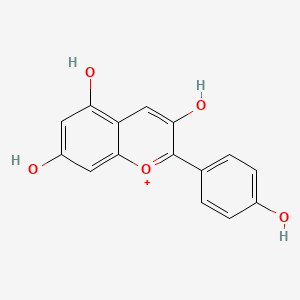| MeSH term | MeSH ID | Detail |
|---|---|---|
| Cystitis | D003556 | 23 associated lipids |
| Parkinsonian Disorders | D020734 | 20 associated lipids |
Pelargonidin
Pelargonidin is a lipid of Polyketides (PK) class. The involved functions are known as Uptake, Intestinal Absorption, glucose uptake, Process and Metabolic Inhibition. Pelargonidin often locates in Serosal, Mucous Membrane, brush border membrane, Membrane and Cell surface. The associated genes with Pelargonidin are SLC5A1 gene, SLC2A2 gene, Homologous Gene, F3 gene and CRSP3 gene. The related experimental models are Knock-out.
Cross Reference
Introduction
To understand associated biological information of Pelargonidin, we collected biological information of abnormalities, associated pathways, cellular/molecular locations, biological functions, related genes/proteins, lipids and common seen animal/experimental models with organized paragraphs from literatures.
What diseases are associated with Pelargonidin?
There are no associated biomedical information in the current reference collection.
Possible diseases from mapped MeSH terms on references
We collected disease MeSH terms mapped to the references associated with Pelargonidin
PubChem Associated disorders and diseases
What pathways are associated with Pelargonidin
There are no associated biomedical information in the current reference collection.
PubChem Biomolecular Interactions and Pathways
Link to PubChem Biomolecular Interactions and PathwaysWhat cellular locations are associated with Pelargonidin?
Visualization in cellular structure
Associated locations are in red color. Not associated locations are in black.
Related references are published most in these journals:
| Location | Cross reference | Weighted score | Related literatures |
|---|
What functions are associated with Pelargonidin?
Related references are published most in these journals:
| Function | Cross reference | Weighted score | Related literatures |
|---|
What lipids are associated with Pelargonidin?
There are no associated biomedical information in the current reference collection.
What genes are associated with Pelargonidin?
Related references are published most in these journals:
| Gene | Cross reference | Weighted score | Related literatures |
|---|
What common seen animal models are associated with Pelargonidin?
Knock-out
Knock-out are used in the study 'MATE2 mediates vacuolar sequestration of flavonoid glycosides and glycoside malonates in Medicago truncatula.' (Zhao J et al., 2011).
Related references are published most in these journals:
| Model | Cross reference | Weighted score | Related literatures |
|---|
NCBI Entrez Crosslinks
All references with Pelargonidin
Download all related citations| Authors | Title | Published | Journal | PubMed Link |
|---|---|---|---|---|
| Hoshino A et al. | Spontaneous mutations of the flavonoid 3'-hydroxylase gene conferring reddish flowers in the three morning glory species. | 2003 | Plant Cell Physiol. | pmid:14581624 |
| Matsufuji H et al. | Identification of reaction products of acylated anthocyanins from red radish with peroxyl radicals. | 2003 | J. Agric. Food Chem. | pmid:12720408 |
| Safari MR and Sheikh N | Effects of flavonoids on the susceptibility of low-density lipoprotein to oxidative modification. | 2003 | Prostaglandins Leukot. Essent. Fatty Acids | pmid:12878454 |
| Kammerer D et al. | Detection of peonidin and pelargonidin glycosides in black carrots (Daucus carota ssp. sativus var. atrorubens Alef.) by high-performance liquid chromatography/electrospray ionization mass spectrometry. | 2003 | Rapid Commun. Mass Spectrom. | pmid:14587087 |
| Su V and Hsu BD | Cloning and expression of a putative cytochrome P450 gene that influences the colour of Phalaenopsis flowers. | 2003 | Biotechnol. Lett. | pmid:14719829 |
| Choung MG et al. | Anthocyanin profile of Korean cultivated kidney bean (Phaseolus vulgaris L.). | 2003 | J. Agric. Food Chem. | pmid:14611168 |
| Kuskoski EM et al. | Characterization of anthocyanins from the fruits of baguaçu (Eugenia umbelliflora Berg). | 2003 | J. Agric. Food Chem. | pmid:12926896 |
| Seeram NP et al. | Inhibition of proliferation of human cancer cells and cyclooxygenase enzymes by anthocyanidins and catechins. | 2003 | Nutr Cancer | pmid:12925310 |
| Fossen T et al. | Anthocyanins with 4'-glucosidation from red onion, Allium cepa. | 2003 | Phytochemistry | pmid:14630001 |
| Wang SY et al. | Elevated carbon dioxide increases contents of antioxidant compounds in field-grown strawberries. | 2003 | J. Agric. Food Chem. | pmid:12848504 |
